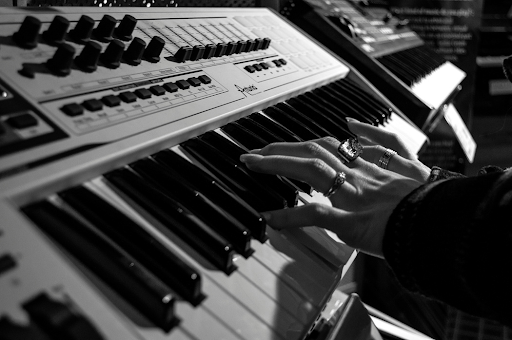Modern music production relies heavily on keyboard synthesisers to create innovative synthesiser sounds and textures. Whether in electronic, pop, or film music, these instruments allow artists to push boundaries and unlock creative potential. Understanding synth programming equips musicians to craft unique audio experiences. For those looking to enhance their skills, professional guidance is available at Studio 72, where aspiring musicians can explore modern synthesis in depth.
Understanding Keyboard Synthesisers
A keyboard synthesiser is more than a piano-like instrument. It generates sounds electronically, offering digital and analogue synthesis options. Core components include oscillators, filters, envelopes, and LFOs.
Types of synthesis commonly found in keyboards include:
- Subtractive Synthesis
- Additive Synthesis
- Frequency Modulation (FM)
- Wavetable Synthesis
Learning these principles is crucial for keyboard synthesiser techniques for modern music and allows musicians to design their own signature sounds.
The Role of Synthesisers in Contemporary Music
Keyboard synthesisers have revolutionised modern music production and performance. From electronic and pop to hip-hop and cinematic scores, they allow musicians to craft unique synthesiser sounds, add depth to compositions, and explore creative musical expression. In these genres, they provide:
- Unique Sound Textures
- Layering and Depth
- Live Performance Enhancements
Famous tracks, from classic synth-pop hits to cinematic scores, often rely on synthesiser technology to define their identity. Practising synth programming and experimenting with synthesiser sounds enhances a musician’s versatility.
Popular Synthesiser Models and Their Unique Sounds
Several synthesiser models have become iconic in modern music due to their distinctive tones and versatile features. Understanding these models helps musicians explore different keyboard synthesiser sounds and expand their creative possibilities. Some synthesiser models have become iconic due to their distinctive tones:
- Moog Sub 37
- Roland JUNO Series
- Korg Minilogue
- Yamaha MODX
Each model has unique features, and exploring them helps musicians develop creative sound design with synthesisers. Beginners can also benefit from structured practice in keyboard lessons to learn these models efficiently.
Creative Techniques Using Synthesisers
To fully unlock the potential of keyboard synthesisers and enhance your music production, musicians can explore a range of creative techniques. Applying these methods helps improve synth programming skills, develop unique synthesiser sounds, and expand overall musical expression.
Some effective techniques include:
- Layering Sounds
- Modulation and Effects
- Hybrid Synthesis
- Sound Experimentation
Regular practice with these techniques improves proficiency in synthesiser programming and strengthens creative expression in music.
Learning to Play and Program Synthesisers

Mastering both playing and programming keyboard synthesisers is essential for modern musicians aiming to create unique sounds and enhance their performance. Developing these skills builds a strong foundation in synthesiser techniques and allows beginners to experiment confidently.
Beginners should:
- Learn signal flow and synthesis principles
- Practice patch creation and modulation techniques
- Explore rhythm, melody, and harmony integration
Professional instruction accelerates learning. Students can develop strong foundations at Studio 72, receiving personalised support and structured guidance tailored to their level.
Common Mistakes and How to Avoid Them
Even with regular practice, beginners and intermediate players often encounter predictable challenges when learning keyboard synthesisers. Recognising these common mistakes early helps improve technique, accelerate learning, and make synthesiser programming more effective.
Beginners should watch for:
- Overcomplicating Patches
- Neglecting Keyboard Skills
- Ignoring Layering and Effects
Correcting these mistakes early, ideally with guidance, ensures a smoother learning experience.
Resources and Support for Synth Players
Learning and mastering keyboard synthesisers goes beyond individual practice. Access to reliable resources, expert guidance, and supportive communities can accelerate progress and inspire new creative ideas. Effective practice involves:
- Books, online tutorials, and synthesis communities
- Experimenting with different patches and models
- Seeking personalised advice to optimise practice and overcome challenges
Consistent exploration paired with structured instruction helps musicians develop confidence and mastery in both sound design with synthesiser and performance. Contact us for personalised guidance and professional tips to improve your keyboard synthesiser skills and enhance your music performance.
Conclusion
Keyboard synthesisers are pivotal in modern music, offering infinite creative possibilities. From exploring analogue warmth to digital versatility, understanding synthesiser components, programming, and sound design allows musicians to craft unique audio experiences. Beginners can benefit from keyboard lessons to establish a solid foundation, experiment with various models, and unlock their full creative potential.
FAQs
What is a keyboard synthesiser used for in music?
A keyboard synthesiser is used to create and manipulate electronic sounds in music production. It allows musicians to design unique tones, from classic analogue warmth to complex digital synthesiser sounds, which can be applied in pop, electronic, and film music.
How do I choose the right synthesiser for beginners?
When choosing the best keyboard synthesisers for beginners, consider versatility, ease of use, and available sound features.
What are the differences between analogue and digital synthesisers?
Analogue synthesisers generate sounds through electronic circuits, producing warm and organic tones. Digital synthesisers use software algorithms, offering more variety and complex sound shaping options. Understanding both types helps musicians experiment with sound design with synthesiser techniques.
Can synthesiser techniques be applied to live performance?
Yes. Techniques like layering, modulation, and real-time synth programming can enhance live performance. Musicians can create dynamic textures and expressiveness using both analogue and digital synthesiser sounds during concerts or live sessions.
Are there lessons available to learn synthesiser programming and playing?
Structured keyboard lessons are ideal for learning synthesiser playing and sound design. With guided instruction, beginners can explore different synthesiser models, develop modern music techniques, and build professional-level skills in synth programming and performance.






